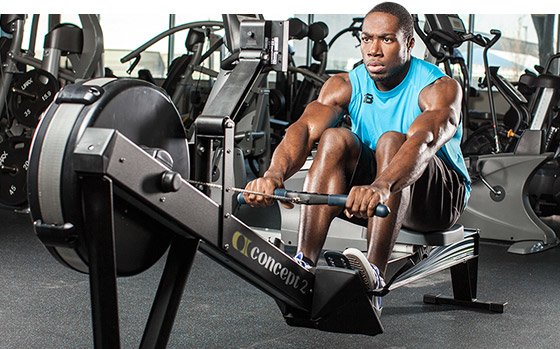
Cardio Controversy - Are You Dropping Too Much?
Whether you are starting a totally new fitness regime or you are a gym-rat - you probably have questions about cardio. How much? When? What's too much? Learn the answers and the benefits of cardio here!
Cardiovascular exercise is a vital part of every fitness regimen but along with implementing it into your daily active lifestyle may come a variety of questions such as "What is the best kind of cardio?", "How much cardio should I do to be effective," "How do I know when I am overtraining?" and "What are the best ways to rest and recover from overtraining?"
These questions are very common and I am here to provide you with the knowledge you need about cardio to either help you design or supplement an effective fitness regimen.
Question 1: What Is The Best Kind Of Cardio?
Many want to know if there is one form of cardio that's better than another. While some people opt to crank out their cardio in the gym on indoor cardio equipment such as the elliptical trainer, Stairmaster or treadmill, others turn to the great outdoors to get their sweat on.
Regardless of the kind of cardio you enjoy, whether it be bicycling, jogging or jumping rope, as long as you elevate your heart rate and keep it within your target heart rate zone, you are doing effective cardio exercise.

According to the American Heart Association, you should perform cardio exercise within your target heart rate zone. The way you can calculate your maximum heart rate by using the Karnoven Method which is basically calculating 220 minus your age. It is important to stay within 50 to 85% of your maximum heart rate zone in order to be effective.
Heart Rate |
||
| Age | Target HR Zone 50-85% | Average Maximum Heart Rate |
| 20 years | 100-170 beats per minute | 200 beats per minute |
| 25 years | 98-166 beats per minute | 195 beats per minute |
| 30 years | 95-162 beats per minute | 190 beats per minute |
| 35 years | 93-157 beats per minute | 185 beats per minute |
| 40 years | 90-153 beats per minute | 180 beats per minute |
| 45 years | 88-149 beats per minute | 175 beats per minute |
| 50 years | 85-145 beats per minute | 170 beats per minute |
| 55 years | 83-140 beats per minute | 165 beats per minute |
| 60 years | 80-136 beats per minute | 160 beats per minute |
| 65 years | 78-132 beats per minute | 155 beats per minute |
| 70 years | 75-128 beats per minute | 150 beats per minute |
Just like anything, it's important to have a balanced approach when constructing your fitness program. While some studies suggest that intense cardio is great for burning maximum calories in minimal time, other studies have indicated that prolonged cardio training can actually diminish the muscle-building effects of resistance training.
The key is to listen to your body and be cautious that you don't over train your muscles. To keep things fresh, try incorporating a variety of activities into your exercise program. You can always mix up your routine by adding speed or distance, increasing/decreasing the incline on your indoor cardio equipment or if you are exercising outdoors, you can simply change your route. All of these variations can improve fitness, prevent injury, and keep your motivation high.
Question 2: How Much Cardio Is Enough?
Ideally your fitness program should be a balance of both cardio and resistance training. You don't want to do too little or too much. Overtraining will take a toll on your body thus causing you to lose the muscle you are working so hard to gain/maintain through resistance/weight training; therefore you don't want to be counterproductive.
Generally a cardio session should last between 30-90 minutes, depending on one's stamina and fitness level. It is acceptable to do 3-5 days of moderate cardio per week but be sure to listen to your body's reaction to exercise.

Question 3: How Do I Know When I Am Overtraining?
Too much cardio may also have negative effects on your metabolism, the same way that eating too few calories can take a toll on you. Be sure to listen to your body and keep your cardio within your range. Be careful to not "over-do" it. Too much of a good thing can be bad and cause you to take a step in the wrong direction if you do something in excess.
Many seek the best "fitness solution" and might tend to overcompensate by doing too much cardio. Also if you are starting a fitness routine for the first time be sure to not do too much, too soon. When you take the "all-or-nothing" approach, going from a sedentary lifestyle to exercising for 45 minutes or more, 5-6 days per week, your body will not respond favorably causing you to feel fatigued with aching joints and muscles.
You should ease into a fitness routine one day at a time so that you can stick to it rather than becoming frustrated and throw in the towel.

To ensure that you don't deplete your system, be sure to consume enough carbohydrates on a daily basis to fuel your body for vigorous cardio workouts or training sessions. Your diet should be high in protein, complex carbs and fibrous carbs. For best results you should eat 4-5 small meals per day.
Too much cardio will result in muscle loss. If you are working on sculpting your physique you need a balanced approach to your fitness routine. While some may think that they must focus on doing cardio before implementing any sort of weight training, it is proven that weight training helps speed up the metabolism, therefore causing the body to burn more fat.
Signs Of Overtraining
If you see signs of general fatigue, irritability or physical soreness, or if your workouts start feeling harder than before, you'll probably need to take a rest from cardio for a couple of days. When you don't let your body recover you are being counterproductive and putting your health in jeopardy.
Here are some common symptoms of overtraining:
- Feeling fatigued and lacking energy
- General body aches or mild muscle soreness
- Decrease in performance
- Inability to complete workouts
- Headaches
- Insomnia/Sleep Problems
- Lack of motivation
Question 4: What Are The Best Ways To Rest And Recover?
Sometimes taking a few days off from the gym will give your body some time to recover and repair itself both physically and mentally. Also make sure to get enough sleep (at least 7-8 hours a night) and be sure to focus on eating well by getting adequate amounts of protein, complex carbohydrates, and lots of fruits and veggies.
Most importantly, take care of yourself. Make sure you are eating a well-balanced diet and getting adequate sleep. If you're not feeling well, give yourself a break. You may end up doing more harm than good by pushing yourself to exercise if you're getting sick.
Rest And Recovery
Allowing your body to rest and recover for a day (or two) gives your hard working muscles time to repair those tears, and a wonderful thing happens-your muscles start to grow back stronger! Without ample recovery time, you continue breaking down the muscle fibers and that's when fatigue and injury can occur.
By taking one day off from your workouts a week, you are able to give your body the proper rest and recovery that it needs to repair itself.

It is important to balance your exercise with rest and recovery. It is this alteration of adaptation and recovery that will take you to a higher level of fitness. Remember, the greater the training intensity and effort you put into your workouts, the greater the need for planned recovery. There are limits to how much stress the body can tolerate before it breaks down and injury little, too slowly will not result in any improvement.
There are 2 types of recovery that you should be aware of:
Short-Term Recovery Vs Active Recovery
Short-term recovery is active recovery that occurs in the hours immediately after exercise. Active recovery refers to engaging in low-intensity exercise after workouts during both the cool-down phase immediately after a hard workout as well as during the days following the workout.
Another major focus of recovery, immediately following exercise, has to do with replenishing energy stores and fluids lost during exercise. It is important to have a post-exercise meal to aid in your recovery.
This is the time when your soft tissue (muscles, tendons, ligaments) repairs and the chemicals that build up as a result of cell activity during exercise are removed from your system. It is recommended to drink a protein shake after a vigorous workout.
Long-Term Recovery
Long-term recovery refers to recovery that is built in to a seasonal training program. This is usually reserved for athletes and coaches who have well-designed training schedules which include recovery days and or weeks that are built into an annual training schedule.
This is also the reason athletes and coaches change their training program throughout the year (modifications can include adding cross training and also changes in intensity, time, distance and all the other training variables).
Benefits Of Cardio
There are so many health benefits that one can reap from incorporating cardio into their lifestyle including:

- Weight loss
- Stronger heart and lungs
- Increased bone density
- Reduced stress
- Reduced risk of heart disease and some types of cancer
- Temporary relief from depression and anxiety
- More confidence about how you feel and how you look
- Better quality of sleep
- More energy
Conclusion
If you are a beginner, embracing cardio as part of your workout regimen is one of the best things you can do to increase your endurance for exercise. Be sure to pace yourself, know your body's limitations but always challenge yourself and strive for improvement as time goes on!
If you are focusing on increasing your stamina, set small goals on a weekly basis and record your workouts in a journal so that you can continue to challenge yourself. For more articles on exercise and nutrition visit www.AngeliqueMillis.com
